An Intelligent Recognition Method for Low-Grade Fault Based on Attention Mechanism and Encoder–Decoder Network Structure
Abstract
:1. Introduction
2. Methods and Principles
2.1. SE Block
2.2. SE-UNet
3. Model Preparation and Trial Calculations
3.1. Data Preparation
3.2. Data Processing
3.3. Network Hyperparameter Analysis and Selection
3.4. Model Trial Calculations
4. Applications
5. Discussion
6. Conclusions
Author Contributions
Funding
Data Availability Statement
Conflicts of Interest
References
- Xu, Y. Interpretation of seismic profile faults. China Pet. Chem. Stand. Qual. 2012, 33, 50. [Google Scholar]
- Carter, N.; Lines, L. Fault imaging using edge detection and coherency measures on Hibernia 3-D seismic data. Lead. Edge 2001, 20, 64–69. [Google Scholar] [CrossRef]
- Bi, C.; Sun, Y.; Zhou, H. Application of C3 coherence in fault identification of Ningbo tectonic belt. Inn. Mong. Petrochem. Ind. 2015, 41, 125–129. [Google Scholar]
- Li, Q. Application of variance cube technology in the interpretation of small faults in Zhuanlongwan coal mine. Shaanxi Coal 2019, 38, 122–124+130. [Google Scholar]
- He, H.; Wang, Q.; Cheng, H. Multi-scale Edge Detection Technology in Identifying Lower-order Faults. J. Oil Gas Technol. 2010, 32, 226–228+431. [Google Scholar]
- Ma, Y.; Su, C.; Zhang, J.; Liu, J. Low-order fault structure-oriented Canny property edge detection and recognition method. Geophys. Geochem. Explor. 2020, 44, 698–703. [Google Scholar]
- Pedersen, S.; Skov, T.; Randen, T.; Sønneland, L. Automatic Fault Extraction Using Artificial Ants. In SEG Technical Program Expanded Abstracts 2002; Society of Exploration Geophysicists: Houston, TX, USA, 2002. [Google Scholar]
- Zhang, X.; Li, T.; Shi, Y.; Zhao, Y. The Application of Fracture Interpretation Technology Based on Ant Tracking in Sudeerte Oilfield. Acta Geol. Sin. Engl. Ed. 2015, 89, 437–438. [Google Scholar] [CrossRef]
- Chen, X.; Yang, W.; He, Z.; Zhong, W.; Wen, X. The algorithm of 3D multi-scale volumetric curvature and its application. Appl. Geophys. 2012, 9, 65–72. [Google Scholar] [CrossRef]
- Lodhi, H. Computational biology perspective: Kernel methods and deep learning. Wiley Interdiscip. Rev. Comput. Stat. 2012, 4, 455–465. [Google Scholar] [CrossRef]
- Zhou, S.; Chen, Q.; Wang, X. Active deep learning method for semi-supervised sentiment classification. Neurocomputing 2013, 120, 536–546. [Google Scholar] [CrossRef]
- Brosch, T.; Tam, R. Manifold Learning of Brain MRIs by Deep Learning. In Medical Image Computing and Computer-Assisted Intervention (MICCAI); Spring: Berlin/Heidelberg, Germany, 2013. [Google Scholar]
- Mangos, P.; Noël, A.; Hulse. Advances in machine learning applications for scenario intelligence: Deep learning. In Theoretical Issues in Ergonomics Science; Taylor & Francis: London, UK, 2017; Volume 18. [Google Scholar]
- Yang, J.; Ding, R.; Lin, N.; Zhao, L.; Zhao, S.; Zhang, Y.; Zhang, J. Research progress of intelligent identification of seismic faults based on deep learning. Prog. Geophys. 2022, 37, 298–311. [Google Scholar]
- Tang, S.; Wang, Z. Semantic Segmentation of Street Scenes Based on Double Attention Mechanism. Comput. Mod. 2021, 10, 69–74. [Google Scholar]
- Shang, J.; Liu, Y.; Gao, X. Semantic segmentation of road scene based on multi-scale feature extraction. Comput. Appl. Softw. 2021, 38, 174–178. [Google Scholar]
- Liu, J.; Zhang, Y.; Tang, L.; Zhen, Y. Lane Line Detection and Fitting Method Based on Semantic Segmentation Results. Automob. Appl. Technol. 2022, 47, 30–33. [Google Scholar]
- Taghanaki, S.; Abhishek, K.; Cohen, J.; Cohen-Adad, J.; Hamarneh, G. Deep Semantic Segmentation of Natural and Medical Images: A Review. Artif. Intell. Rev. 2020, 54, prepublish. [Google Scholar] [CrossRef]
- Li, H.; Iwamoto, Y.; Han, X. An Efficient and Accurate 3D Multiple-Contextual Semantic Segmentation Network for Medical Volumetric Images. In Proceedings of the 2021 43rd Annual International Conference of the IEEE Engineering in Medicine and Biology Society, Piscataway, NJ, USA, 1–5 November 2021. [Google Scholar]
- Ai, C.; Song, Y.; Lv, Q. Research on a medical image semantic segmentation algorithm based on deep learning. Basic Clin. Pharmacol. Toxicol. 2021, 128, 184. [Google Scholar]
- Wang, X.; Li, Z.; Lyu, Y. Medical image segmentation based on multi⁃scale context⁃aware and semantic adaptor. J. Jilin Univ. Eng. Technol. Ed. 2022, 52, 640–647. [Google Scholar] [CrossRef]
- Yu, T. Based on the improved fast iris localization of semantic segmentation model. Mod. Comput. 2020, 15, 121–125. [Google Scholar]
- Wang, C.; Sun, Z. A Benchmark for Iris Segmentation. J. Comput. Res. Dev. 2020, 57, 395–412. [Google Scholar]
- Zhou, R.; Shen, W. PI-Unet: Research on Precise Iris Segmentation Neural Network Model for Heterogeneous Iris. Comput. Eng. Appl. 2021, 57, 223–229. [Google Scholar]
- Wu, X.; Liang, L.; Shi, Y.; Fomel, S. FaultSeg3D: Using synthetic data sets to train an end-to-end convolutional neural network for 3D seismic fault segmentation. Geophysics 2019, 84, IM35–IM45. [Google Scholar] [CrossRef]
- Wu, J.; He, S.; Yang, Q.; Guo, A.; Wu, J. Research on low-order fault identification method based on fully Convolutional Neural Network (FCN). In Proceedings of the SPG/SEG Nanjing 2020 International Geophysical Conference, Nanjing, China, 13–16 September 2020. [Google Scholar]
- Liu, Z.; He, X.; Zhang, Z.; Zhou, Q.; Zhang, S. Low-order fault identification technique based on 3D U-NET full Convolution Neural Network(CNN). Prog. Geophys. 2021, 36, 2519–2530. (In Chinese) [Google Scholar]
- Yang, J.; Chen, S. U-net with residual module is applied to fault detection. In Proceedings of the SPG/SEG Nanjing 2020 International Geophysical Conference, Nanjing, China, 13–16 September 2020. [Google Scholar]
- Chang, D.; Yong, X.; Wang, Y.; Yang, W.; Li, H.; Zhang, G. Seismic fault interpretation based on deep convolutional neural networks. Oil Geophys. Prospect. 2021, 56, 1–8. [Google Scholar]
- Feng, C.; Pan, J.; Li, C.; Yao, Q.; Liu, J. Fault high-resolution recognition method based on deep neural network. Earth Sci. 2020, 1–15. [Google Scholar] [CrossRef]
- Zhang, H. Research on Desert Seismic Random Noise Suppression Based on Convolutional Autoencoder Neural Network with Attention Module; Jilin University: Jilin, China, 2021. [Google Scholar]
- Yang, C.; Zhou, Y.; He, H.; Cui, T.; Wang, Y. Global context and attention-based deep convolutional neural network for seismic data denoising. Geophys. Prospect. Pet. 2021, 60, 751–762+855. [Google Scholar]
- Han, L.; Chai, Z.; Song, L.; Liu, X.; Fu, C. Reverse Time Migration Compensation Method of Seismic Wave Based on Deep Learning. Well Logging Technol. 2022, 46, 109–113. [Google Scholar]
- Zhang, M. A multiple suppression method based on self-attention convolution auto-encoder. Geophys. Prospect. Pet. 2022, 61, 454–462. [Google Scholar]
- Hu, J.; Shen, L.; Albanie, S.; Sun, G.; Wu, E. Squeeze-and-Excitation Networks. In Proceedings of the IEEE Transactions on Pattern Analysis and Machine Intelligence, Salt Lake City, UT, USA, 18–23 June 2018. [Google Scholar]
- Wu, X.; Geng, Z.; Shi, Y.; Pham, N.; Fomel, S.; Caumon, G. Building realistic structure models to train convolutional neural networks for seismic structural interpretation. Geophysics 2019, 85, 4745–4750. [Google Scholar]
- Luo, Q.; Huang, H.; Wang, B. Genetic types of low-grade faults and their geologic significance. Pet. Geol. Recovery Effic. 2007, 19–21+25+112. [Google Scholar] [CrossRef]

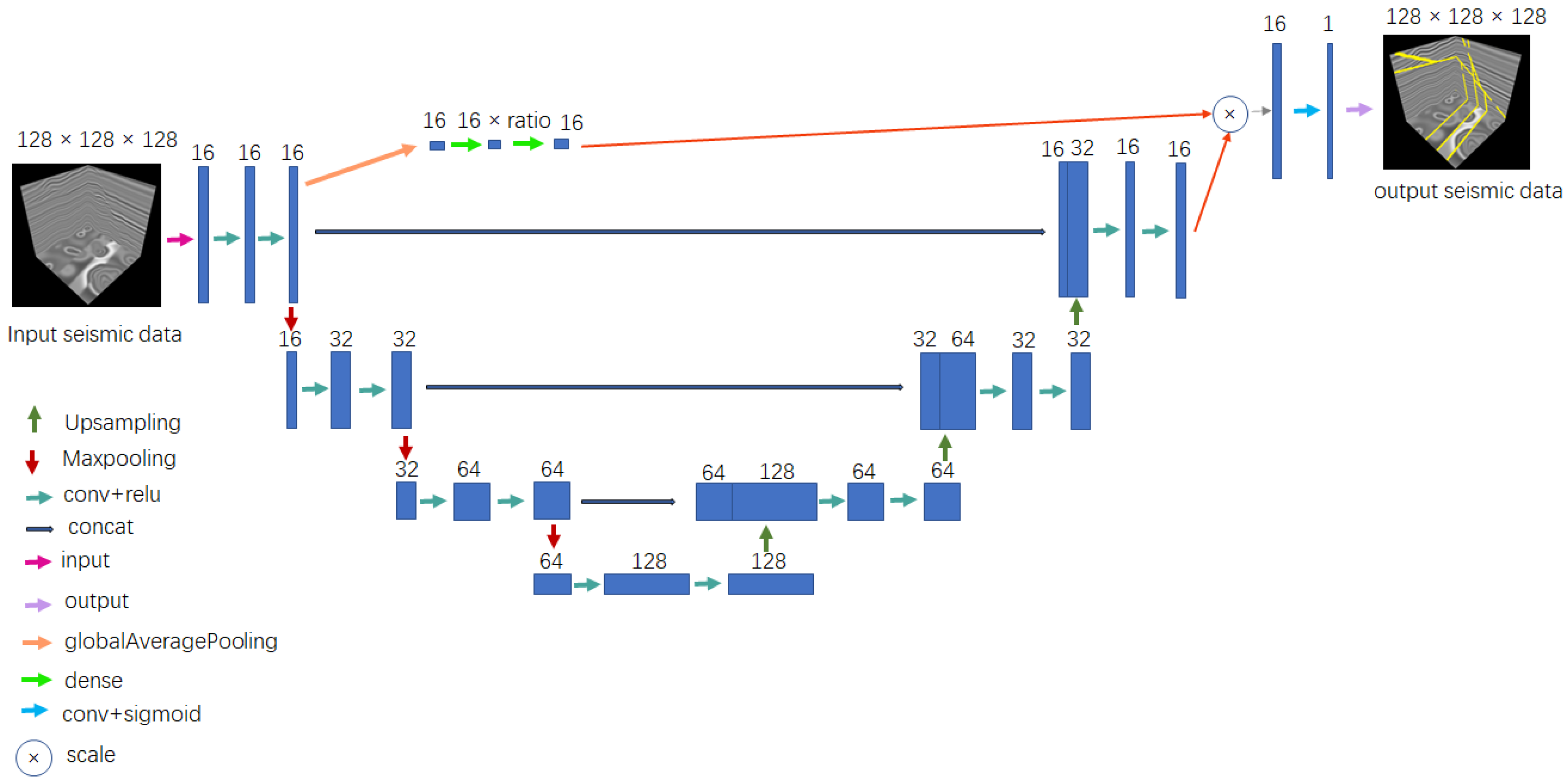

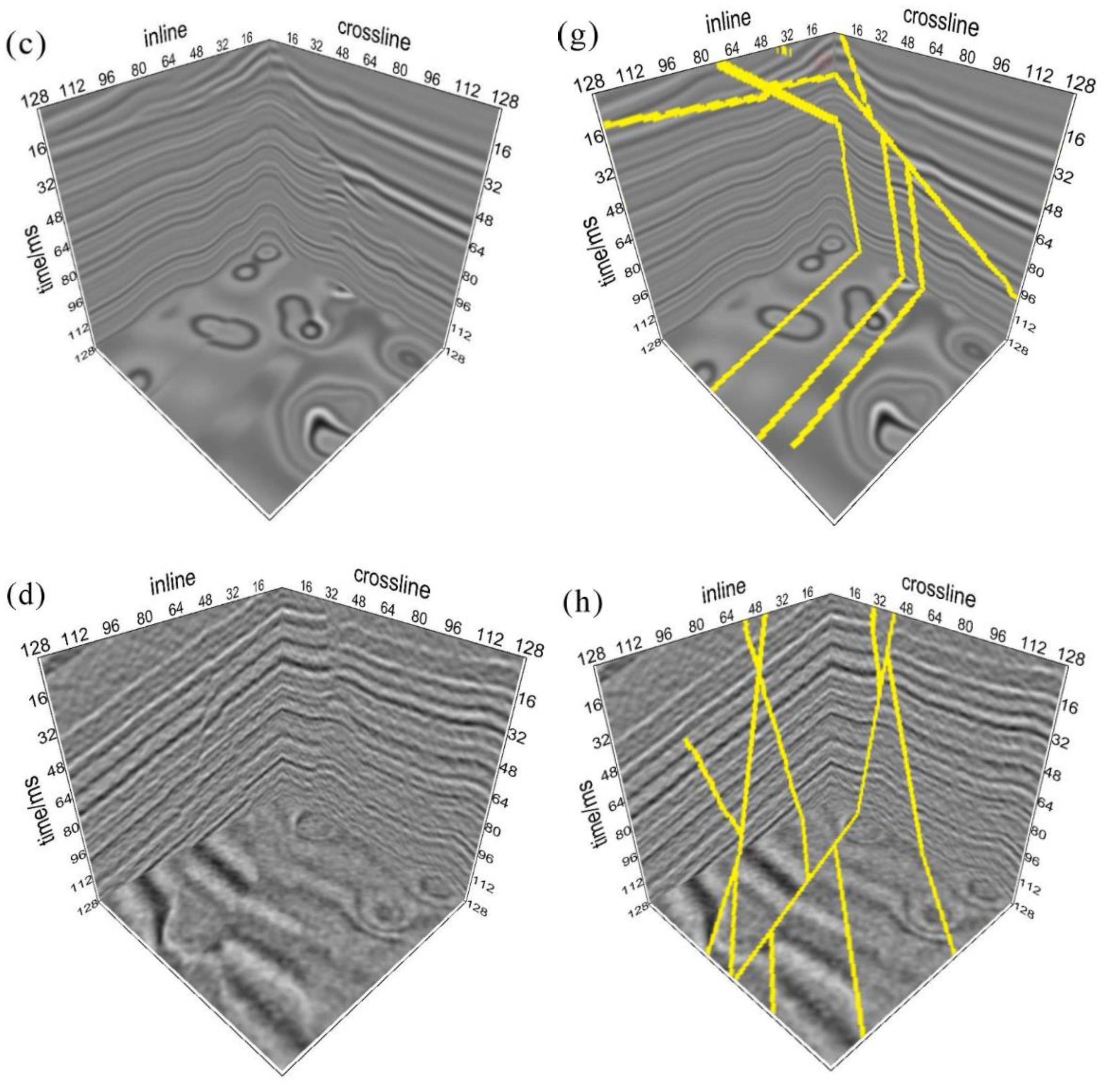
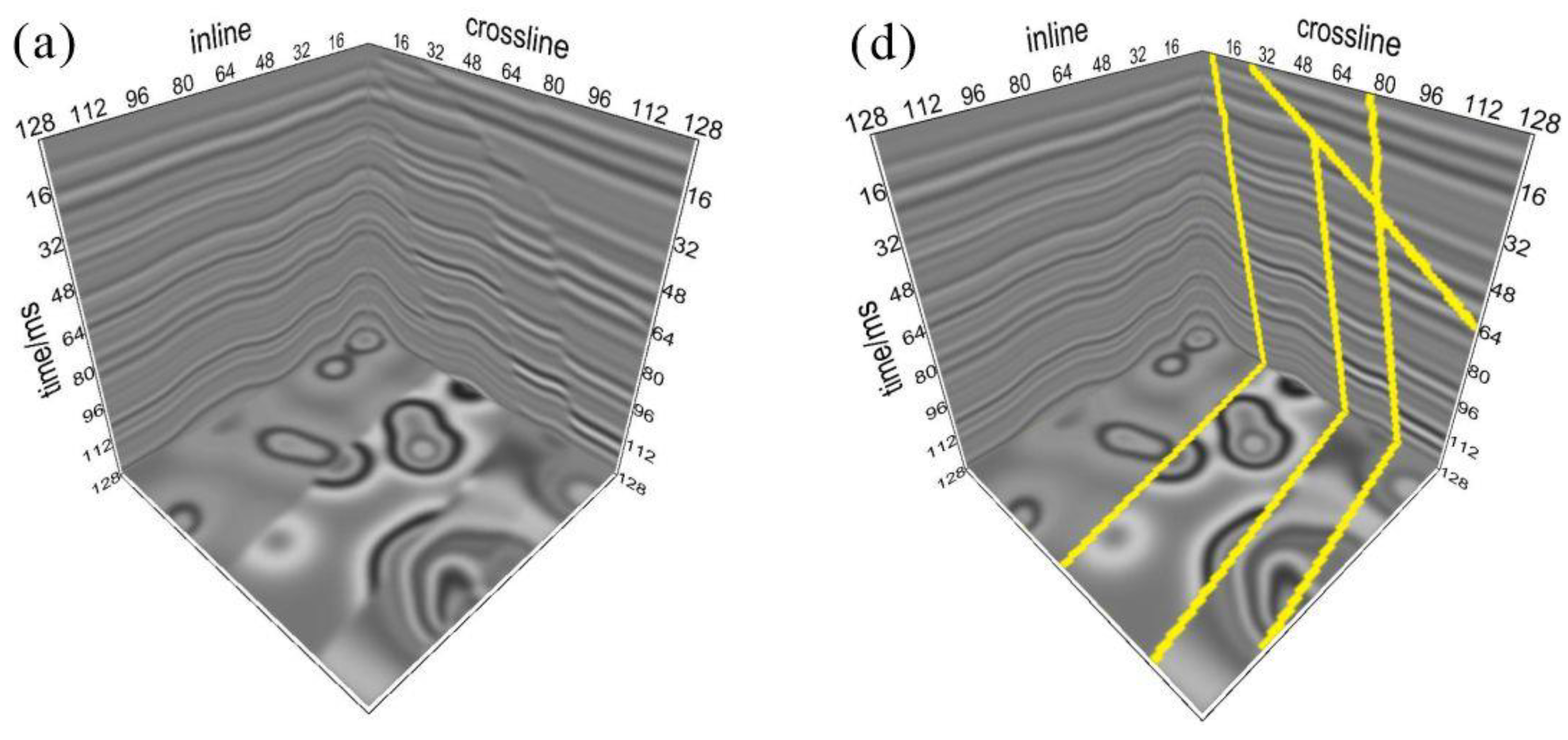
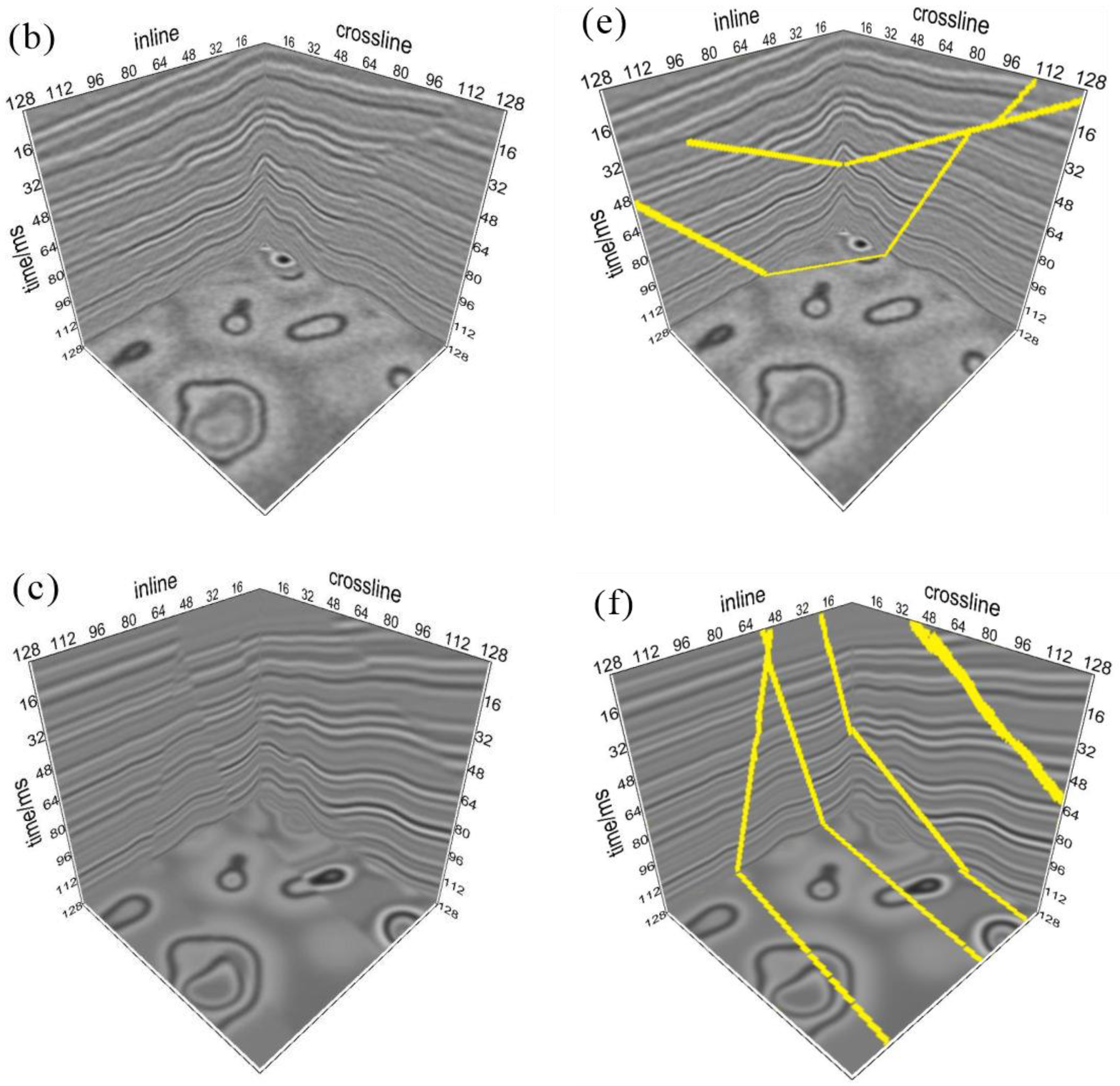
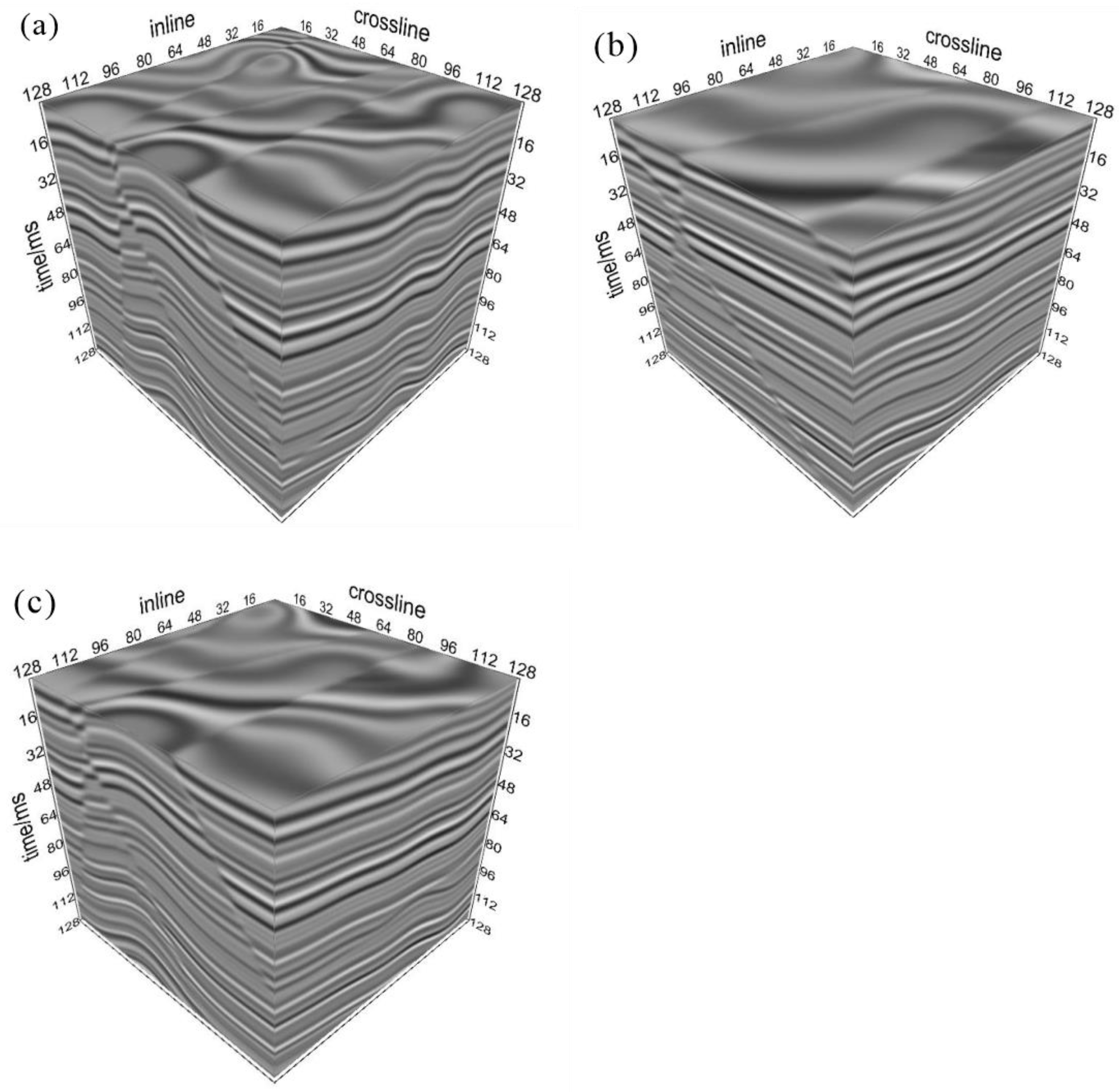
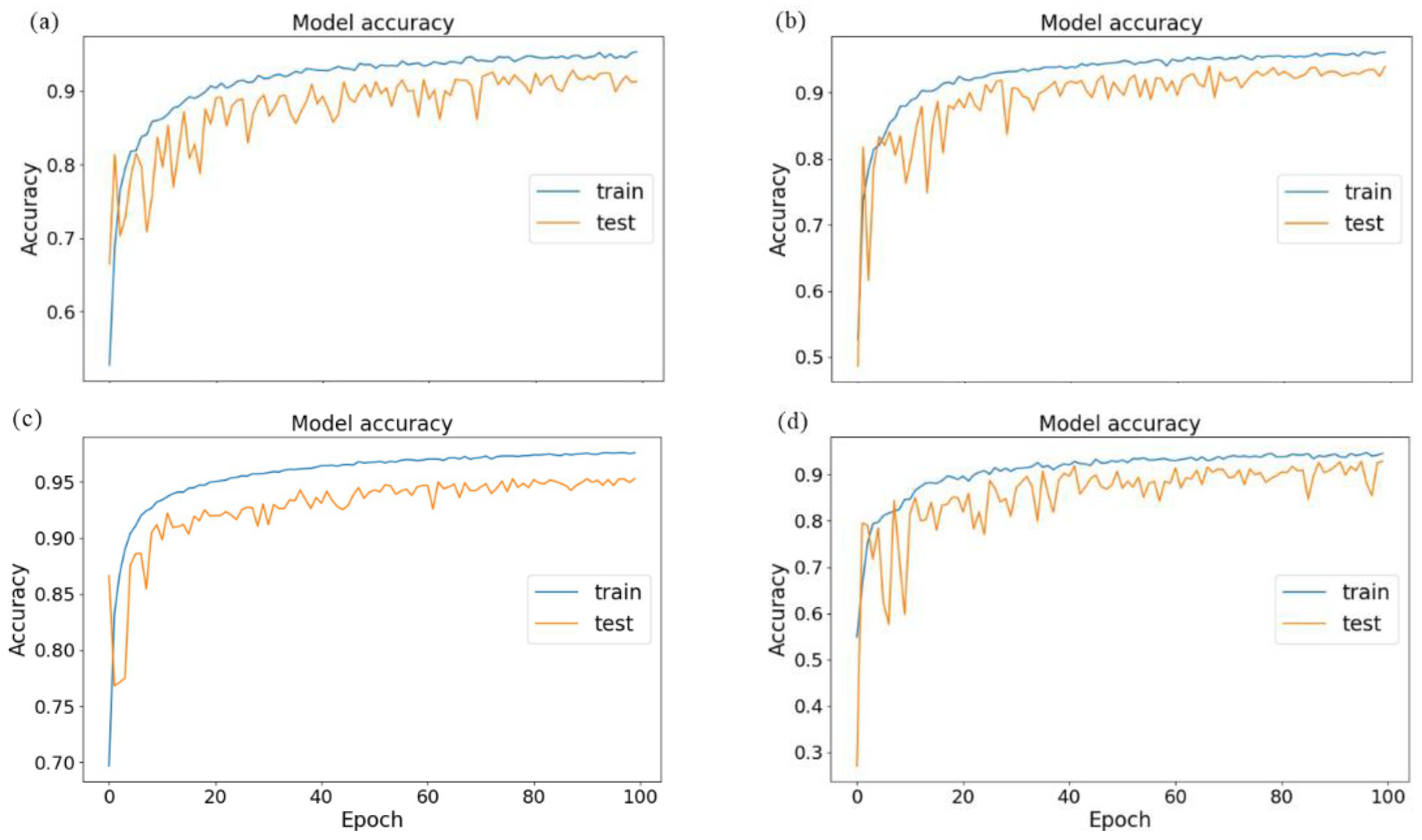
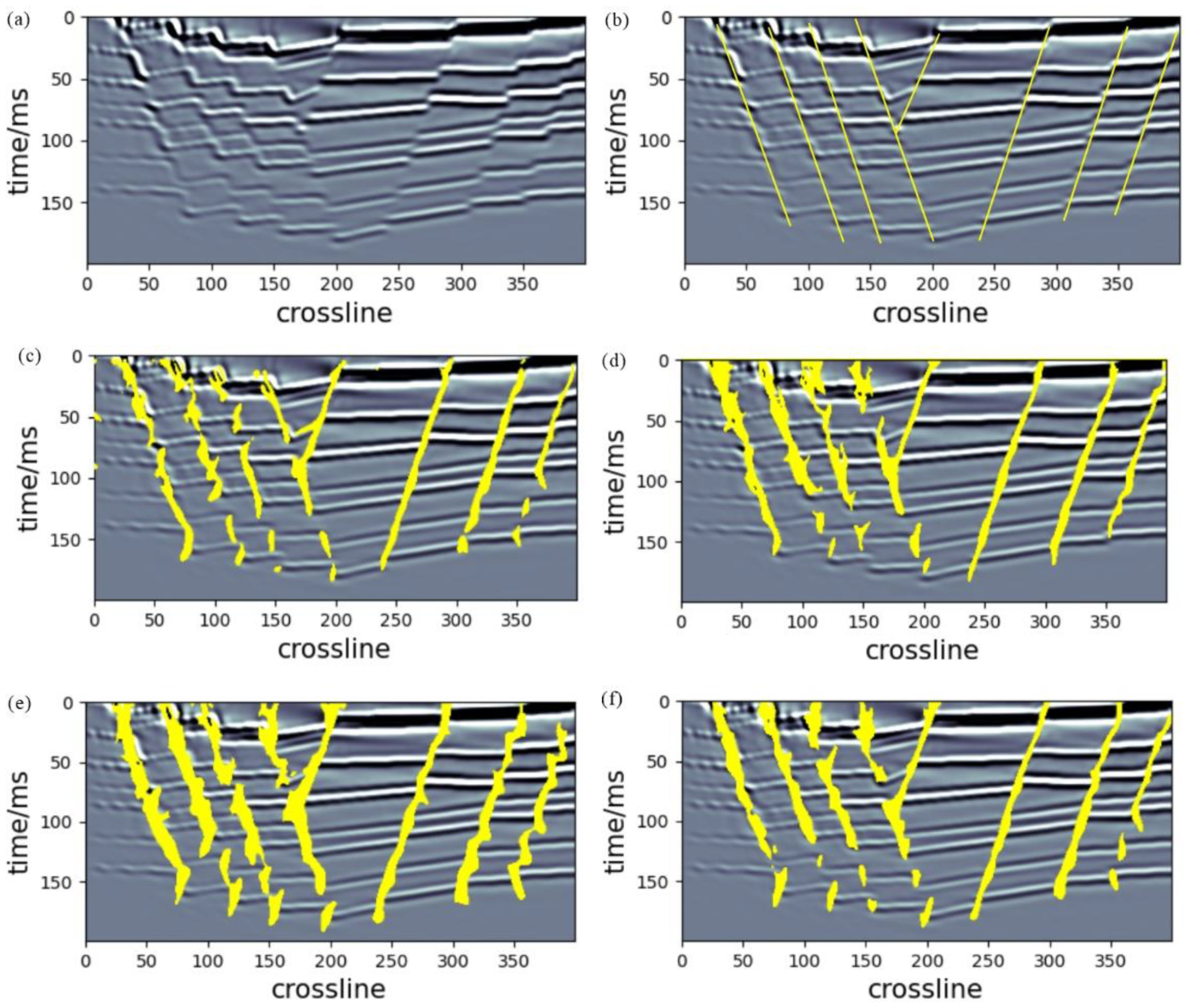


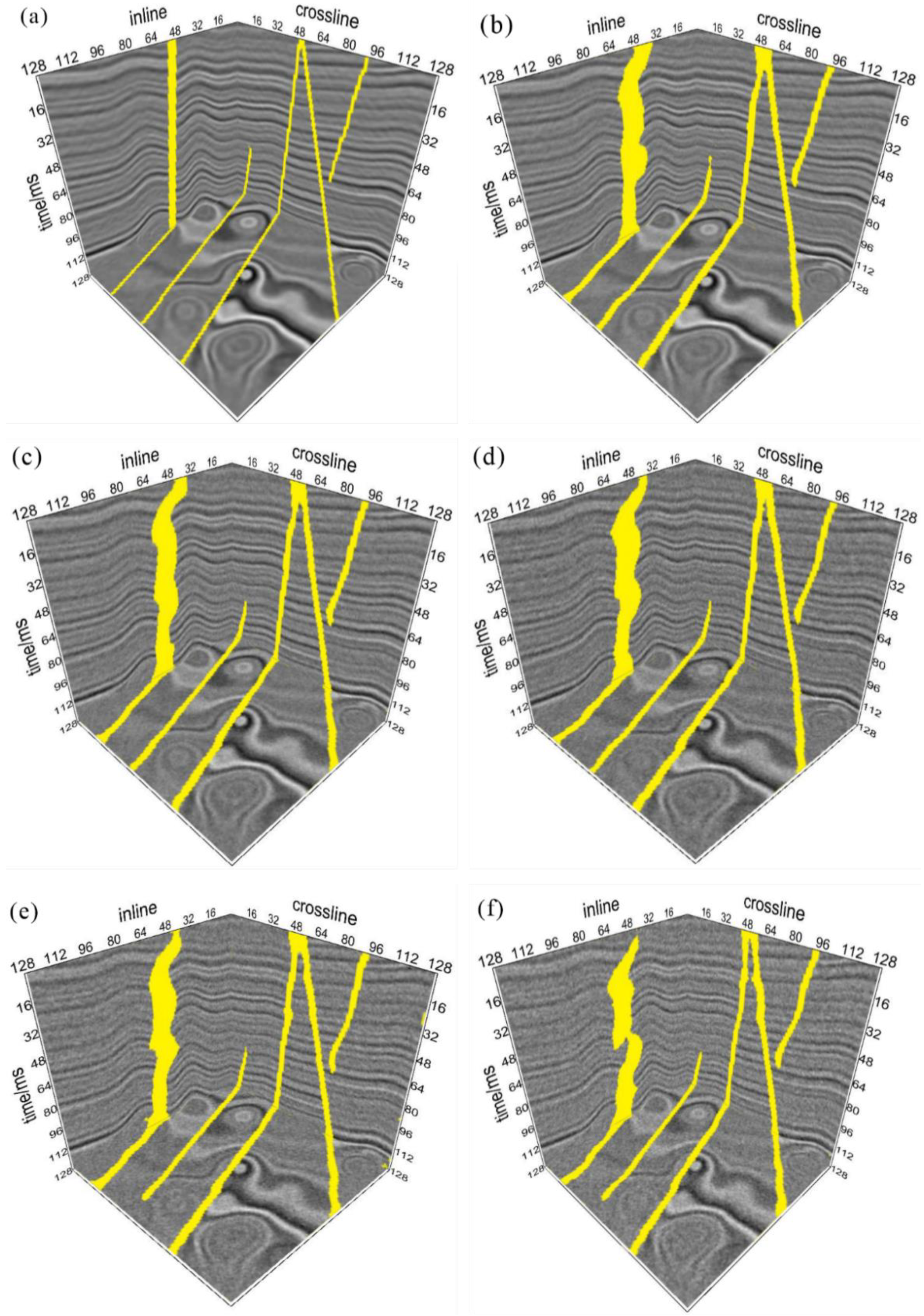
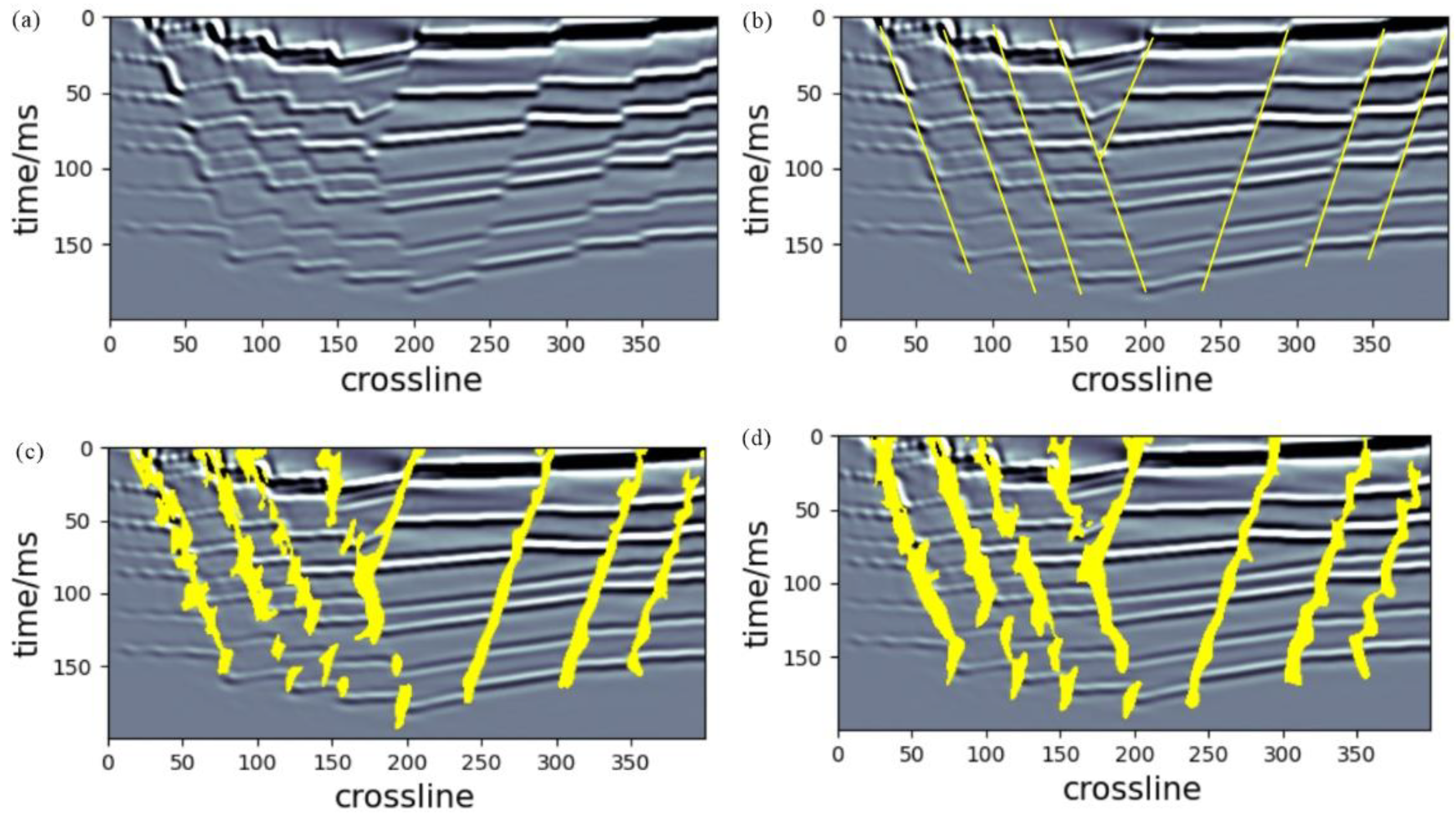
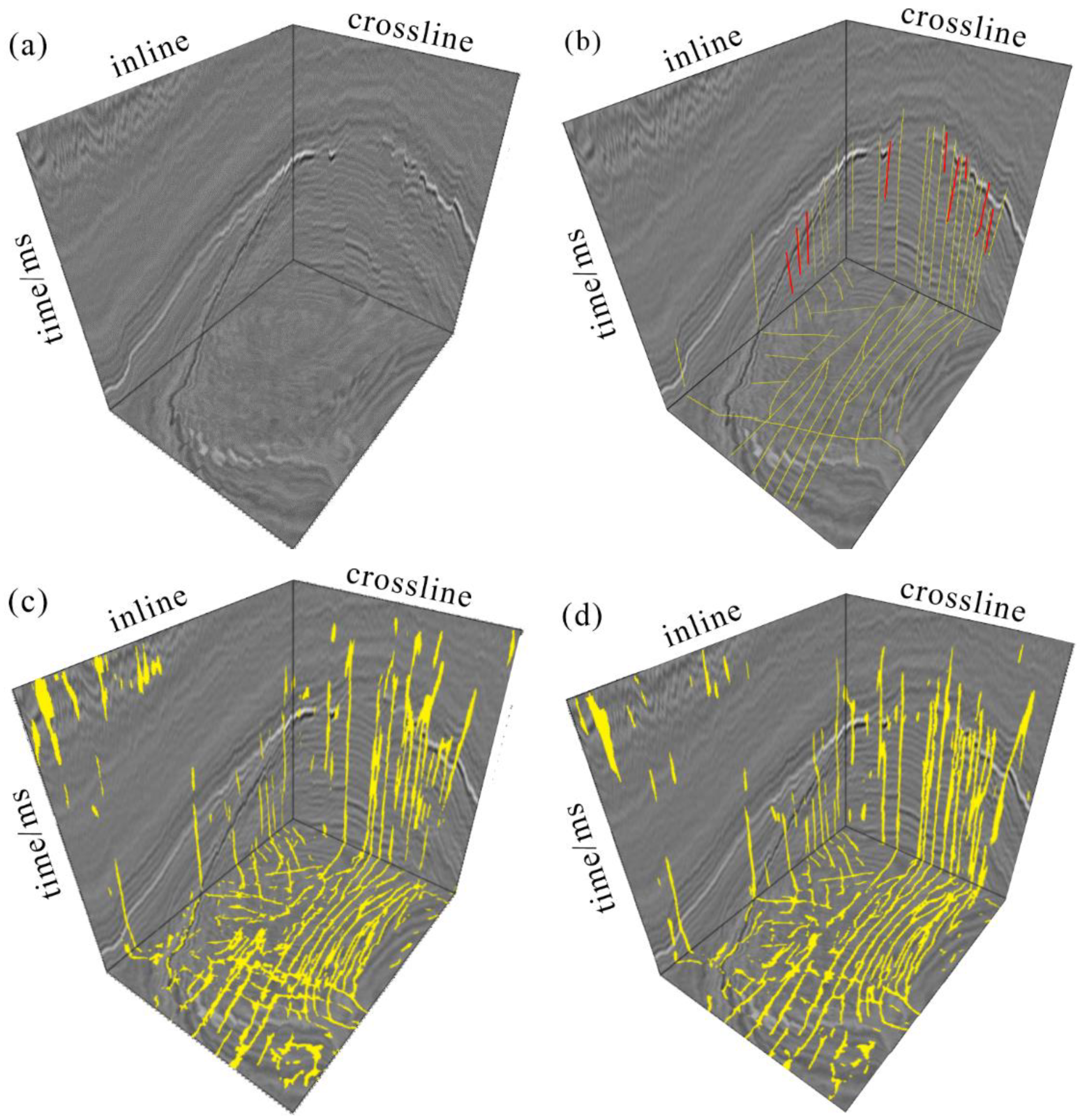
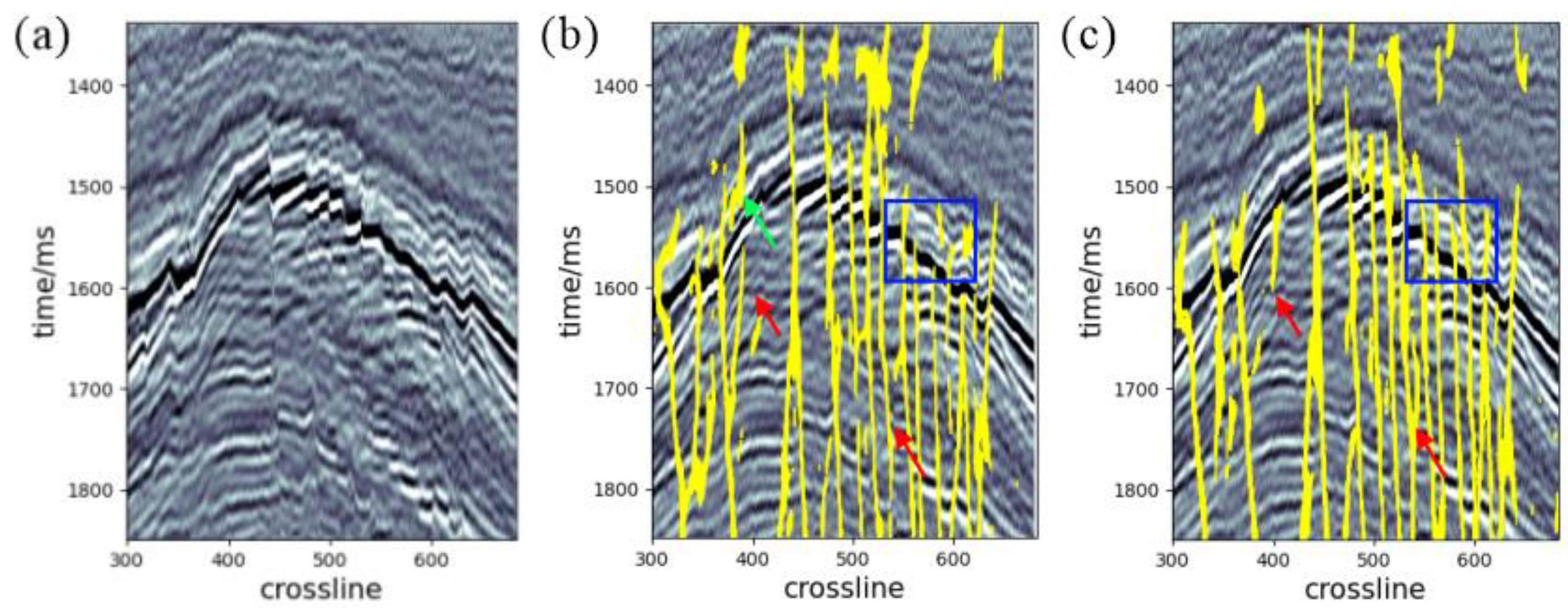

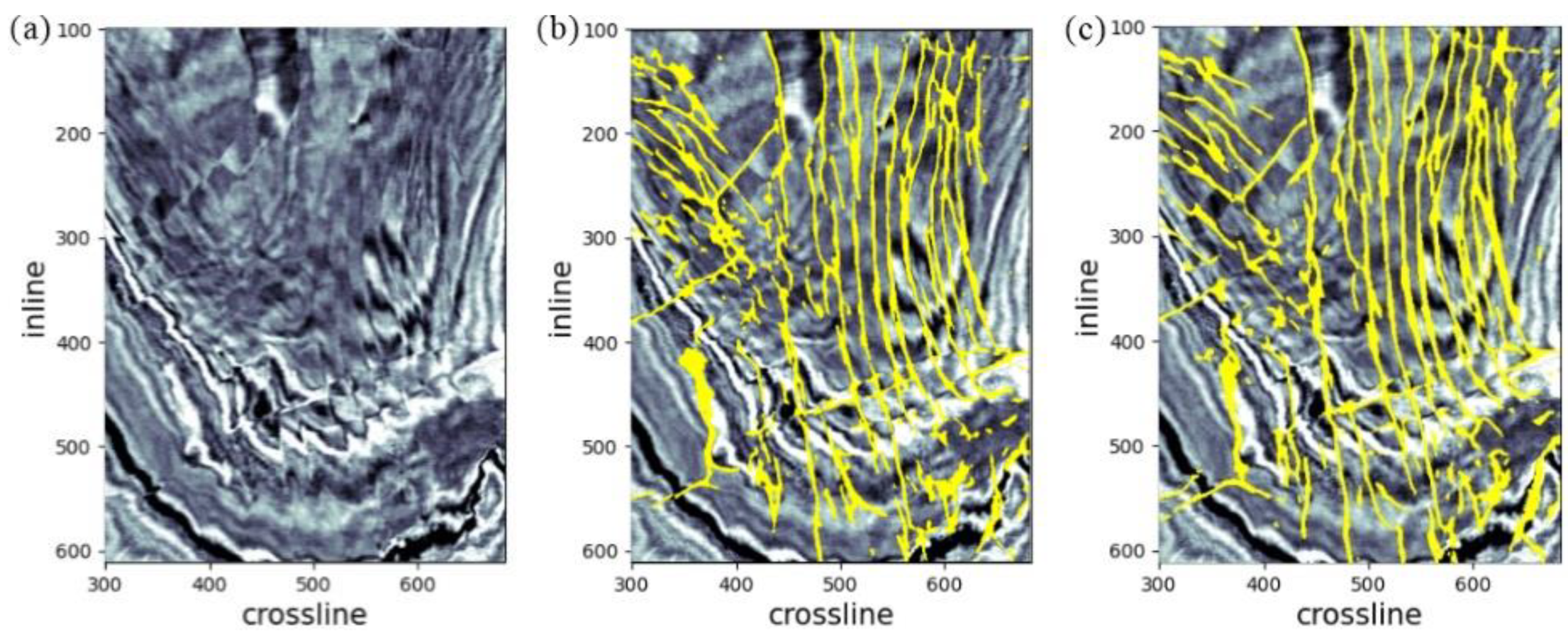
| Evaluation Standards | Meanings |
|---|---|
| True positives (TP) | Predicted to be faulted, actual fault |
| True negatives (TN) | Predicted to be non-fault, actual non-fault |
| False positives (FP) | Predicted to be faulted, actually non-faulted |
| False negatives (FN) | Predicted to be non-faulted, actually faulted |
| Evaluation Metrics | UNet | SE-UNet |
|---|---|---|
| Train_acc (%) | 95.61 | 97.52 |
| Test_acc (%) | 93.25 | 95.23 |
| Train_recall (%) | 98.19 | 98.25 |
| Test_recall (%) | 95.36 | 97.31 |
Publisher’s Note: MDPI stays neutral with regard to jurisdictional claims in published maps and institutional affiliations. |
© 2022 by the authors. Licensee MDPI, Basel, Switzerland. This article is an open access article distributed under the terms and conditions of the Creative Commons Attribution (CC BY) license (https://creativecommons.org/licenses/by/4.0/).
Share and Cite
Zhang, Y.; Wang, D.; Ding, R.; Yang, J.; Zhao, L.; Zhao, S.; Cai, M.; Han, T. An Intelligent Recognition Method for Low-Grade Fault Based on Attention Mechanism and Encoder–Decoder Network Structure. Energies 2022, 15, 8098. https://doi.org/10.3390/en15218098
Zhang Y, Wang D, Ding R, Yang J, Zhao L, Zhao S, Cai M, Han T. An Intelligent Recognition Method for Low-Grade Fault Based on Attention Mechanism and Encoder–Decoder Network Structure. Energies. 2022; 15(21):8098. https://doi.org/10.3390/en15218098
Chicago/Turabian StyleZhang, Yujie, Dongdong Wang, Renwei Ding, Jing Yang, Lihong Zhao, Shuo Zhao, Minghao Cai, and Tianjiao Han. 2022. "An Intelligent Recognition Method for Low-Grade Fault Based on Attention Mechanism and Encoder–Decoder Network Structure" Energies 15, no. 21: 8098. https://doi.org/10.3390/en15218098
APA StyleZhang, Y., Wang, D., Ding, R., Yang, J., Zhao, L., Zhao, S., Cai, M., & Han, T. (2022). An Intelligent Recognition Method for Low-Grade Fault Based on Attention Mechanism and Encoder–Decoder Network Structure. Energies, 15(21), 8098. https://doi.org/10.3390/en15218098






